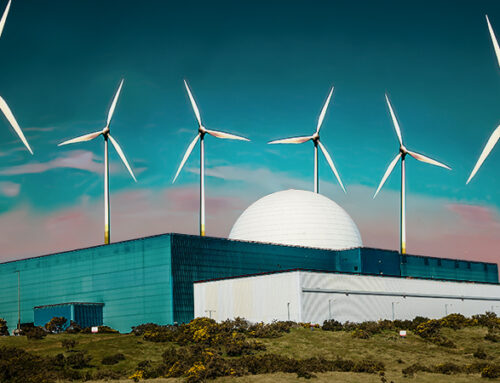There has been a slew of energy market news in the past couple of days, but none of it is good. Yesterday, Zog Energy became the 29th energy supplier to fail this year. The company had 11,700 domestic customers and has entered the Supplier of Last Resort (“SOLR”) process. Zog was one of the suppliers affected by the failure of gas shipper CNG. Zog’s founders have said that they always purchased gas forwards from CNG, but that shipper’s administrators had refused to allow these hedges to be transferred, leaving Zog un-hedged and having to replace those volumes at current higher prices, which it was unable to do.
Elexon credit assessment price set for largest rise yet
Adding further stress to suppliers is the news that Elexon plans yet another increase to its Credit Assessment Price (“CAP”), this time from £230 /MWh to £305 /MWh from 17 December. This is something like the 6th change in the CAP level since early September when the level was at £96/MWh. The current level is £240 /MWh, although it’s set to decline slightly to £230 /MWh tomorrow.
In determining the size of the latest increase, the Credit Committee gave greater weighting the latest forecast for December prices – on the date of the meeting, the average forecast market prices were at £224 /MWh for December with latest peak prices at £253 /MWh and latest base prices at £196 /MWh. The Committee also noted that average January price had increased to £255 /MWh. The most recent System Prices were also considered, and it was noted that prices in the Balancing Mechanism have been high in recent days. Given the chance of a colder weather along with high Balancing Mechanism prices, the Committee believes System Price spikes are likely.

While December prices had supported a slight reduction in the CAP level previously (due to be implemented tomorrow) the recent increase together with the higher prices for January are motivating this current proposed rise. However, the proposed increase is significantly above both current and forecast prices, so it is unclear why the proposal is for the new level to be at £305 /MWh which is a £50 /MWh premium to December prices, rather than something lower.
“Given the chance of colder weather and high prices in the Balancing Mechanism, the Credit Committee noted that there was likely to be system price spikes during the period when the proposed CAP would be live,”
– Elexon
Last month Elexon began using an alternative credit review process allowing the CAP to be adjusted more quickly in response to rapidly changing market conditions, or where an unusually high increase is indicated. Under this alternative process, the consultation period for changes to the CAP is reduced from 5 to 2 working days and the notification period from 15 working days to 10. The Credit Committee is also reviewing the CAP every two weeks. The alternative process allows the Committee to use a wider range of data sources in setting the CAP, including the reference price, forward market prices and previous energy imbalance prices, as well as responses to previous price adjustment consultations.
While suppliers will not be pleased to see such a large increase in the CAP level, Elexon has demonstrated its willingness to reduce the CAP where it believes market conditions allow, and is using a new determination process to enable greater responsiveness to market conditions. It’s just a shame that Ofgem cannot demonstrate similar innovation and flexibility in setting the retail price cap.
UK ETS prices reach record highs
This week, the Cost Containment Mechanism (“CCM”) for the UK ETS was breached for the first time – monthly average UK ETS prices in September, October and November were all above the December trigger price of £52.88 /tCO2. Under current market rules, the Government must consider measures to reduce the cost of allowances if they consistently trade at more than double their average price of the previous two years – since we don’t yet have a two-year trading history for the UK scheme, the Government has set a thresholds based on EU ETS prices between May 2019 and December 2020.
Since the CCM has been triggered, the UK ETS Authority will meet to consider what intervention, if any, to make based on addressing sustained price movements that do not correspond to market fundamentals. If there is no agreement on what action to take, the final decision will be taken by HM Treasury. Potential interventions include:
- redistributing allowances between the current year’s auctions;
- bringing forward auctioned allowances from future years to the current year;
- drawing allowances from the market stability mechanism account;
- auctioning up to 25% of the remaining allowances in the New Entrants Reserve.

The Authority has announced that a decision will be communicated to the market no later than after trading hours on 14 December. Analysts have suggested that with only two auctions remaining for the year the Authority is likely to re-allocate auction volumes next year to bring forward allowances for sale in the beginning of the year.
Ongoing problems at Taishan indicate possible EPR design flaw
There has also been further bad news for EDF’s troubled EPR technology. Unit 1 of the Taishan nuclear power plant in China was shut down in July following a build-up of noble gases in the primary circuit, which was attributed to issues with the casing around some of the fuel rods, the first of three containment barriers at the reactor. An investigation into the cause of the problem is still underway, but a whistle-blower has reported that there may be a design flaw with the reactor pressure vessel, and that this ultimately damaged the containment.
The whistleblower, described as a French engineer who has access to detailed technical information about the Taishan reactor, has linked damage found on the fuel assemblies to “abnormal vibrations” which could be associated with a design flaw in the pressure vessel. In an email, dated 27 November, the Commission for Independent Research and Information on Radioactivity – a French association created in the aftermath of the Chernobyl disaster – asked the French nuclear regulator to investigate the whistle-blower’s claims, since any fault at Taishan could have implications for EPRs EDF is developing in France and elsewhere in Europe.
An industry source told The Times newspaper that the pressure vessel is “demonstrably safe” but that design changes may be needed.
“If the news we are hearing from the Taishan EPR is right then it’s beginning to look like there’s a potential generic fault with the key safety mechanism of the EPR reactor design itself,”
– Paul Dorfman, nuclear expert at the University of Sussex
EDF has said that that investigations at Taishan are still ongoing and declined to comment on whether there would be any impact on Hinkley Point C, but four months on, there is still no information about the cause of the problem – which may not be surprising given lack of transparency in China – but the reactor is still offline, which is perhaps a better indication that safety concerns remain.
EDF is yet to complete any of its EPRs – neither the first scheme in Olkiluoto, Finland which was originally due to open in 2009, nor the flagship plant at Flamanville in France which should have opened in 2012 have been completed and both have seen costs escalate to multiples of the original estimates.
The UK Government has committed to approving another large-scale nuclear reactor by the end of this Parliament, and the expectation is that it will progress the EPR at Sizewell C. This would be unwise – until EDF demonstrates that it knows how to deliver an EPR in Europe the Government should not gamble security of supply on a failing technology. I remain convinced that the best option is the Advanced Boiling Water Reactor, and that attempts should be made to revive the Hitachi scheme at Wylfa Newydd.
.
As winter begins to bite, there is no sign of any end to the current chaos in energy markets.






With my engineering head on I do not shed a tear for the loss of another parasitic fantasy energy supplier. They contributed little as shown by continued uninterrupted power supplies (except for the result of the recent storm – that is another unprecedented event and a possible issue of under investment in the real world) . A blind eye has been turned to their suspect structures as they helped peddle the myth of competition and of people being able to buy 100% renewable electricity.
CAP and CCM prices going up and down and BM prices going from negative to large positive over a half hour period – what a fantastic game.
In the real world large engineering projects always have ups and downs (particularly nuclear) but even Dungeness B managed to safely produce low carbon power. Like all investment decisions it is unwise to put all your eggs on one basket.
I actually sympathise with the BM “game” since thermal generators need to earn returns one way or another and with utilisation levels falling those ways will be either in the BM or capacity market. I very much doubt any of them are making excess profits with gas and carbon prices where they are, but overall I agree that the market is very distorted and dysfunctional.
Hi Kathryn…….thanks for an yet another excellent summary.
Your points are well received amidst masses mis-information swirling around the media.
Lots of downbeat news associated with EPR technology from around the world & possible impact on the future of UK projects.
However my concern is more about today’s position.
Little wind, virtually no solar why is the input from our nuclear fleet so depressed ?
Surely with national supply/demand on a knife edge there should be more GW’s from EDF.
The total contribution from UK nuclear of 5 GW equal or less than 5/10 GW from wind, as I type.
Meanwhile daily demand of 45 GW nudging north & a lagging frequency causes me to dwell on what could occur at any time soon; low wind, below freezing temperatures (Beast from the East springs to mind)
Time to stock up on candles……..Barry Wright Lancashire.
You can check out the nuclear status here:
https://www.edfenergy.com/energy/power-station/daily-statuses
EDF has now taken reactor 3 of Hunterston B out of the market permanently with the other reactor set to close in January, and there are 3 reactors on planned outages and one on an un-planned outage. We can expect nuclear reliability to decline as the fleet ages – this is my major beef with NG ESO’s winter outlook which assumes nuclear availability will be the average of the last 3 years – that would be questionable at the best of times, but Hunterston B and Hinkley Point B both set to permanently close in January then that assumption seems unrealistic.
Fascinating, even though I only understand half the details of the modern market. (I was involved with setting up the Nuclear Electric Energy Management Centre between November ’89 and May ’91). But, as a nuclear engineer, I find it hard to see why an issue with the Taishan reactor pressure vessel might cause failures in fuel pin cladding. An extreme event (like a loss of coolant incident leading to relatively fast depressurisation) could certainly stress the fuel cladding, but so far as I am aware nothing like that has been reported.
That’s interesting. Do you read anything into the time this is taking to address with Taishan still being offline?
“That’s interesting. Do you read anything into the time this is taking to address with Taishan still being offline?”
Difficult to speculate, and I am not at all familiar with the detailed engineering of the EPR. EDF (France) who no doubt know quite a lot about what is going on said (while the plant was still running) that they would have shut it down if it had been in France. A week later, the Chinese shut it down. EDF apparently warned Biden that there could be an “imminent radiological threat”. For that to happen, radioactivity has to escape from the fuel cladding into the primary coolant (which it has, in relatively modest quantities), then from the reactor pressure vessel into the secondary containment, something which normally only happens in relatively unusual circumstances (such as at Three Mile Island), and then from the secondary containment to the outside world. There was a small release at TMI because, if I recall correctly, there was a route via a secondary building that by-passed the filtration system that would normally prevent a significant release. I’m guessing that filtration is activated carbon, as in the case of the famous filter gallery at the top of the chimneys of the Windscale air-cooled plutonium producing “piles”, one of which caught fire in 1957. Now, in “big” accidents the radionuclide that usually causes the most concern is iodine, with caesium as another contributor. These are important because they get captured in the body if you inhale them. But their chemical activity means that they are also effectively removed by activate charcoal. Now, the radioactivity that has been mentioned in the Taishan context is “noble gases”, this will be mainly Krypton and Xenon. These are sort of the opposite of iodine and caesium: they are not trapped by activated carbon, but equally they are not readily absorbed in the body either. So they are not intrinsically as dangerous. There is a risk, because if an atom decays while it is in your lung, the decay product is likely to stay there and this may still be radioactive. The same thing applies to naturally occurring radon, as found in mines, and leaking out of the ground. If it decays in your lung, it can leave something nasty behind. Might it be that the Chinese (and French) are worrying that the fuel pin leaks are “the tip of the iceberg” rather than being “the tail of the distribution”. My understanding is that, as with every reactor before this, failure of a handful of pins within a reactor inventory of tens of thousands is considered tolerable, but that does assume it is *not* a developing fault. Ultimately, to get at the fuel they will have to take the lid off the reactor and hence release any radioactivity into the containment building. But if this activity is, principally, krypton and xenon (which cannot be trapped by active carbon filters) then there could be an issue in managing it. There are certainly technological solutions, for example freezing it out. If this is the issue, then it is a problem with the containment building design, and not with the reactor pressure vessel design, as implied by the whistle-blower. There must be plenty of points of access to the primary coolant circuit (for example the pressuriser, or the coolant chemistry circuits, where radioactive gas could be bled off into a freeze-trap. That’s not to say that the engineering would be easy.